

| ETERNUS SF AdvancedCopy Manager Operator's Guide 13.0 -Solaris- |
Contents
Index
 
|
This chapter explains the backup operation using the QuickOPC (the old name: Differential OPC) function.
For a snapshot high-speed backup using OPC, the entire transaction volume must be copied to the backup volume every time the backup (OPC) is started. However, as long as the same pair of the transaction volume and backup volume is used, the entire transaction volume need not be physically copied every time OPC is started. Instead, physically copying only the difference data from the start of the previous backup can create a complete snapshot image, which can greatly reduce the time taken for physical copying.
The QuickOPC function copies only the data that has been changed from the point of the previous physical copy. Using this function can reduce the time taken for a physical copy.
The snapshot high-speed backup using the QuickOPC function is referred to as the differential snapshot high-speed backup.
The conventional snapshot high-speed backup and the differential snapshot high-speed backup are compared below:

To implement the differential snapshot high-speed backup using the QuickOPC function, a disk array that supports the QuickOPC function is required.
The QuickOPC function can be used only for an intra-cabinet copy (OPC). It cannot be used for an inter-cabinet copy (ROPC).
The QuickOPC function also cannot be used, for backing up SDX objects in units of logical volumes.

When the QuickOPC function is used, the hardware records the changes made to the copy source and destination after completing the OPC logical copy. The state in which the hardware keeps a record of changes is called the "tracking state."
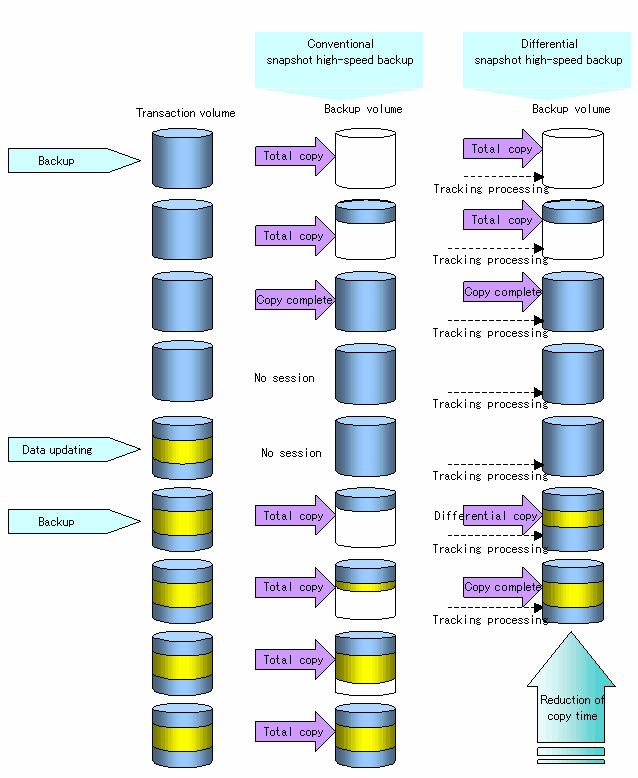
Design the differential snapshot high-speed backup using the QuickOPC function by noting the following in addition to the information given in Operation Design for backup management.

Note the following for the backup policy decision and backup volume preparation:
- In a backup operation using the QuickOPC function, an OPC session remains even after the physical copy. Specify the number of preservation generations so that the maximum number of OPC sessions that can be defined for the same logical unit cannot be exceeded.
- The QuickOPC function can be used only for an intra-cabinet copy (OPC). It cannot be used for an inter-cabinet copy (ROPC). Prepare a backup volume in the same cabinet as the transaction volume to be backed up.
A flow of operation using the QuickOPC function is shown below.
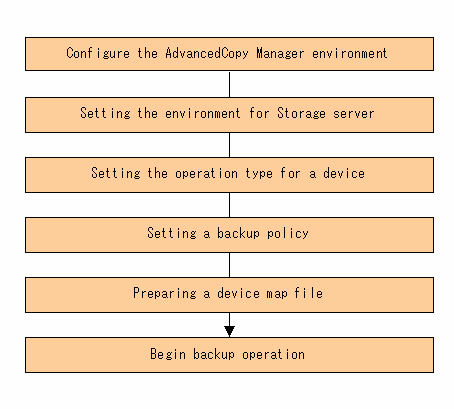
This section explains the preparation for a backup operation using the QuickOPC function.
For a series of operations from the installation to the operating environment configuration of AdvancedCopy Manager, see the ETERNUS SF AdvancedCopy Manager Installation Guide and ETERNUS SF AdvancedCopy Manager Operations Guide.
Set the configuration information of the storage server used for backup operation.
Use the storage server configuration information setup command (swstsvrset) to set the storage server configuration information. The storage server configuration information that has been set can be referenced using the storage server configuration information display command (swstsvrdisp).
Register a transaction volume as the backup source and a backup volume to be used as the backup destination. Register the transaction volume and backup volume using the device information setup command (swstdevinfoset) or the device information setup window of the Web screen.
Information on the registered volumes can be referenced using the device use status display command (swstdevdisp).
Volumes in the tracking state can be checked using the tracking status display command (swsttrkstat).

The settings of the transaction volume in the tracking state cannot be changed.
The settings of the backup volume in the tracking state cannot be changed.

The -b and -u options can be specified together in the device use status display command to check for backup volumes, whose histories were deleted, in the suspend or tracking state.
When a backup policy is set, as many usable backup volumes as needed to perform the operation in accordance with the specified backup policy must have been registered.
Set a backup policy using the backup policy setup command (swstbkpolset) or the backup policy setup window on the Web screen.
The backup policy that has been set can be referenced using the backup policy display command (swstbkpoldisp) or the transaction volume list window of the Web screen.
The backup policy can be deleted using the backup policy deletion command (swstbkpoldel) or the backup policy deletion window on the Web screen.
In the AdvancedCopy Manager backup operation, AdvancedCopy Manager automatically selects a device, which has the same capacity as the target transaction volume, as a backup volume from a group of registered devices
If a backup volume in the tracking state exists when AdvancedCopy Manager looks for a backup volume for the snapshot high-speed backup, it selects the backup volume in the tracking state prior to any others and uses it as the backup destination.
When it is needed to recognize the backup destination device for convenience of operation, a device map file that defines the correspondence between a transaction volume and backup volume must be created in advance. By specifying the device map file when starting the backup operation, the backup operation can thus be performed as if the backup destination is specified.

If multiple generations are to be managed, multiple device map files must be prepared.
Execute the differential snapshot high-speed backup by specifying the -T option in the backup execution command (swstbackup).
Executing the backup command by specifying the -T option starts the QuickOPC. When the QuickOPC starts, the physical copy and tracking processing begins. When the physical copy is complete, only tracking processing is active. When the backup command is later executed by specifying the -T option, only the difference data from where OPC was started previously is copied physically.
The figure below shows the conventional snapshot high-speed backup and the differential snapshot high-speed backup.
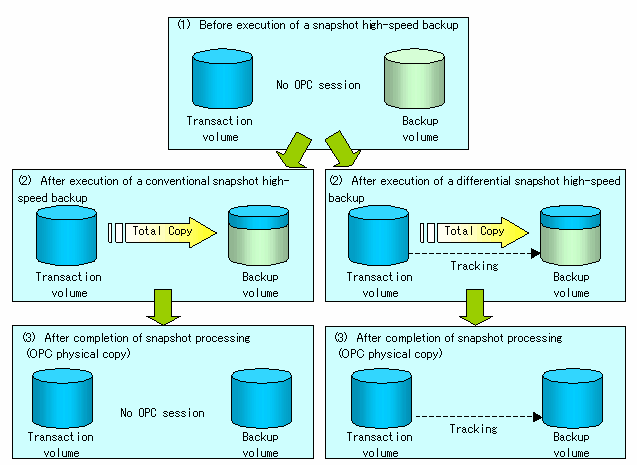
After the history information is deleted in a differential snapshot high-speed backup, the backup volume is put in the tracking state without history information. If a new differential snapshot high-speed backup is started under that condition, the backup volume in the tracking state without history information is selected to start the difference data copy. The physical copy can thus be completed in a short period because only the difference data from where OPC was started previously is copied.
The figure below shows a flow of a differential snapshot high-speed backup operation in which only one generation is preserved.
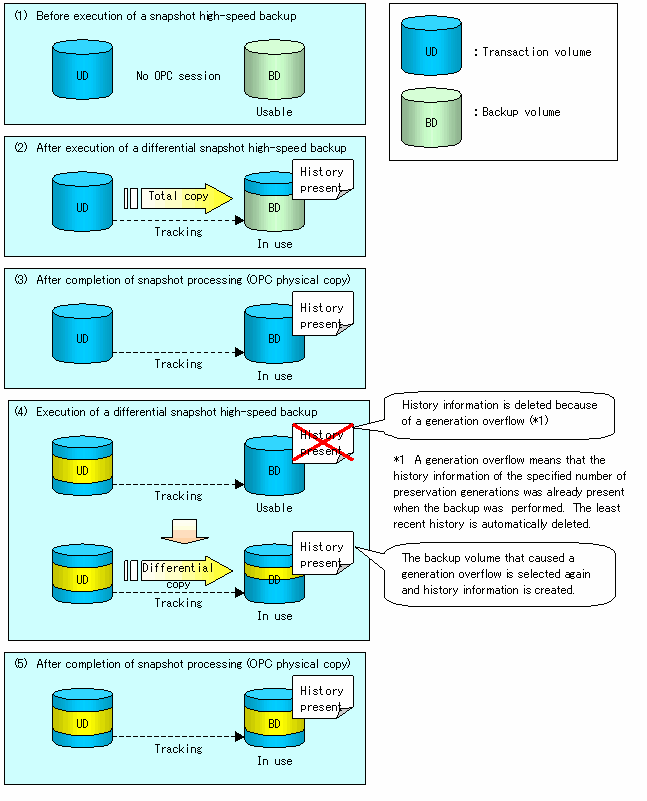

Backup operation using the QuickOPC function cannot be performed from the Web screen.
Backup history information can be referenced using the history information display command (swsthistdisp).
Backup history information can be deleted using the history information deletion command (swsthistdel).
Even if the history information created by the differential snapshot high-speed backup is deleted, the tracking state is not released (physical copy, if in execution, is not stopped).
In the conventional snapshot high-speed backup, after the history information is deleted, the backup volume is released and "Backup (free)" is displayed in the Device-Mode column by the device use status display command (swstdevdisp). In the differential snapshot high-speed backup, however, the backup volume is not released even after the history information is deleted and "Backup (used)" is displayed in the Device-Mode column by the device use status display command.
To check for backup volumes in the tracking state, specify the -u option in the device use status display command. For a backup volume in the tracking state, "Backup (used-T)" is displayed in the Device-Mode column.
The figure below shows a comparison of history deletion between the conventional snapshot high-speed backup and the differential snapshot high-speed backup.
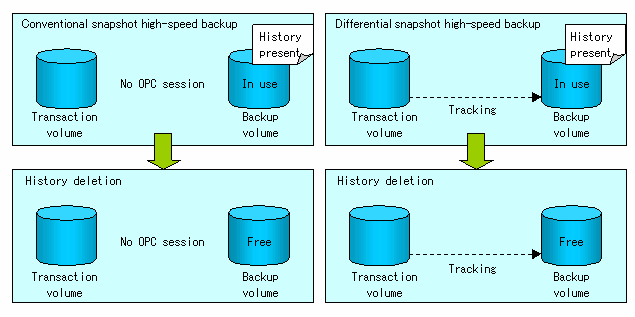
Use the restore execution command (swstrestore) for restoration.
In the differential snapshot high-speed backup, tracking processing from the transaction volume to the backup volume is performed.
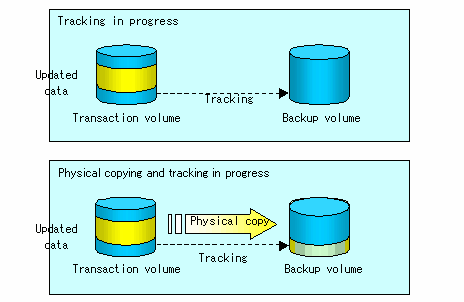
When restoration is executed, ordinary OPC from the backup volume to the transaction volume is started while the tracking state from the transaction volume to the backup volume is maintained. Because OPC for restoration physically copies only the data that has been updated after the backup, the time taken for the physical copy, not only for the backup but also for the restoration, can be reduced.
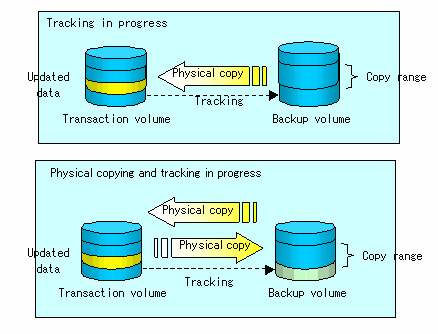
While tracking processing is performed between the transaction volume and backup volume, restoration to other volumes cannot be performed. If restoration to other volumes needs to be performed, the following operations must be performed in advance:
If the OPC physical copy from the transaction volume to the backup volume is in progress, wait for completion of the copy.
Stop tracking processing using the tracking cancel command (swstcanceltrk).
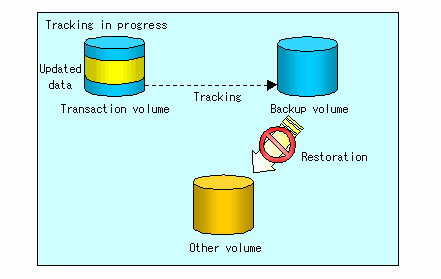

If tracking processing is terminated, all data in the transaction volume is physically copied by the next differential snapshot high-speed backup.
Use the restore cancel command (swstcancelrest) to cancel the restoration.

Canceling the restoration does not release tracking from the transaction volume to the backup volume.
The execution status of tracking processing by the QuickOPC function can be checked with the tracking execution status display command (swsttrkstat).
Information on an OPC session that is not in tracking is excluded from the display. For an OPC session in tracking, the amount of data that has been updated after execution of the QuickOPC (logical copy) is displayed as a percentage in the Update column.
Use the tracking cancel command (swstcanceltrk) to stop tracking processing.

If the command is issued while the physical copy and tracking are in progress, only the tracking is stopped and the physical copy is not stopped.
Contents
Index
 
|